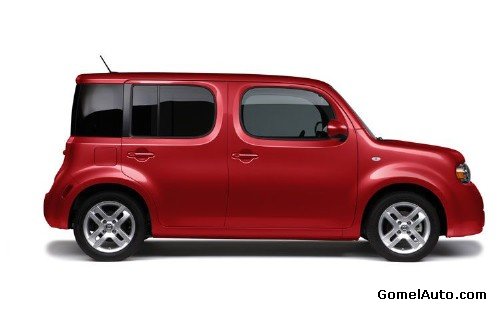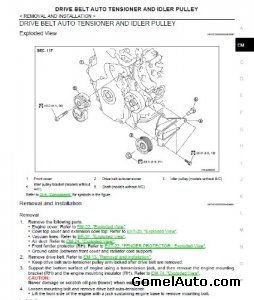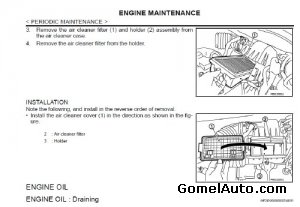
Пытаюсь найти сервис мануал на Ниссан Лафеста, но пока бесплатно нигде не найду.Мимоходом нашёлся сервис мануал на 12 Куб.Не знаю куда пристроить .Может кто поделится с одноклубниками.Мануал на английском.Полно всякой инфы, включая самодиагностику, различные тесты, схемы и так далее.Переводится Гуглом легко.Правда ориентироваться сложновато.
Может кому на Лафесту такой попадётся.Дайте знать.
Делай добро и бросай его в воду…
yadi.sk/d/13eUcai_3Rt9Cn
Войдите или зарегистрируйтесь, чтобы писать комментарии, задавать вопросы и участвовать в обсуждении.
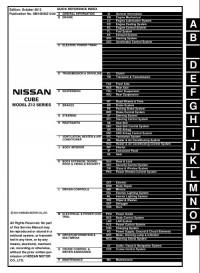
Сборник руководств на английском языке по техническому обслуживанию и ремонту автомобиля Nissan Cube серии Z12 2009-2014 годов выпуска.
- Автор: —
- Издательство: Nissan Motor Co., Ltd.
- Год издания: 2009-2013
- Страниц: —
- Формат: PDF
- Размер: 494,5 Mb
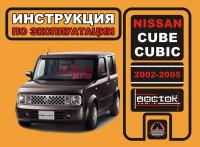
Руководство по эксплуатации и техническому обслуживанию автомобиля Nissan Cube Cubic 2002-2005 годов выпуска.
- Автор: —
- Издательство: Монолит
- Год издания: —
- Страниц: 274
- Формат: —
- Размер: —

Руководство по эксплуатации, техническому обслуживанию и ремонту автомобиля Nissan Cube (правый руль) с 2002 года выпуска с бензиновым двигателем объемом 1,4 л.
- Автор: —
- Издательство: Автонавигатор
- Год издания: 2009
- Страниц: 465
- Формат: —
- Размер: —

Руководство по техническому обслуживанию и ремонту автомобиля Nissan Cube с правым рулем 1998-2002 годов выпуска с бензиновыми двигателями.
- Автор: —
- Издательство: Легион-Автодата
- Год издания: 2011
- Страниц: 376
- Формат: —
- Размер: —
Посмотреть инструкция для Nissan Cube (2014) бесплатно. Руководство относится к категории автомобили, 2 человек(а) дали ему среднюю оценку 8. Руководство доступно на следующих языках: английский. У вас есть вопрос о Nissan Cube (2014) или вам нужна помощь? Задайте свой вопрос здесь
Не можете найти ответ на свой вопрос в руководстве? Вы можете найти ответ на свой вопрос ниже, в разделе часто задаваемых вопросов о Nissan Cube (2014).
Как перевести мили в километры?
1 миля равна 1,609344 километрам, а 1 километр — 0,62137119 милям.
Где я могу узнать идентификационный номер транспортного средства Nissan?
Место размещения идентификационного номера транспортного средства зависит от марки и типа транспортного средства. Номер может быть выбит на раме транспортного средства или указан на номерном знаке. Чтобы узнать место расположения идентификационного номера транспортного средства лучше всего ознакомиться с руководством по эксплуатации Nissan Cube (2014).
Что такое идентификационный номер транспортного средства (VIN)?
Идентификационный номер транспортного средства — уникальный для каждого транспортного средства идентификационный номер. Аббревиатура VIN расшифровывается как «Vehicle Identification Number» (Идентификационный номер транспортного средства).
Когда транспортному средству Nissan требуется техническое обслуживание?
Регулярное техническое обслуживание необходимо всем транспортным средствам. С информацией о том, как часто необходимо проходить техническое обслуживание и чему именно стоит уделять особое внимание можно ознакомиться в инструкции по техническому обслуживанию. Как правило, транспортное средство требует технического обслуживания каждые 2 года или 30 000 километров пробега.
Когда следует заменять тормозную жидкость на Nissan?
Тормозную жидкость рекомендуется менять каждые два года.
В чем разница между топливом E10 и E5?
В топливе E10 содержится до десяти процентов этанола, в то время как в E5 содержится менее пяти процентов. Соответственно, топливо E10 менее вредит окружающей среде.
Одна или несколько дверей не открываются изнутри. Что мне делать?
Скорее всего, замок оснащен защитой от детей и поэтому не может быть открыт изнутри. Процедура открытия замка с защитой от детей зависит от марки и типа замка.
Автомобильный радиоприемник не включается, что делать?
Если автомобильный радиоприемник не включен, на него не будет подаваться питание. Убедитесь, что красный провод подключен к контактному источнику питания, а желтый провод — к источнику питания постоянной мощности.
Инструкция Nissan Cube (2014) доступно в русский?
К сожалению, у нас нет руководства для Nissan Cube (2014), доступного в русский. Это руководство доступно в английский.
Не нашли свой вопрос? Задайте свой вопрос здесь
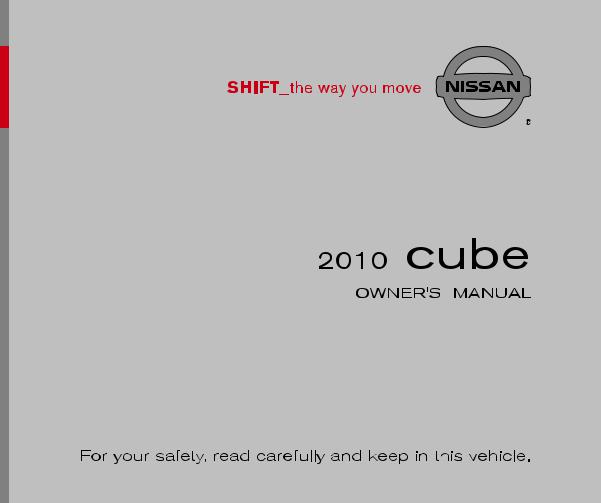

Foreword
Welcome to the growing family of new NISSAN owners. This vehicle is delivered to you with confidence. It was produced using the latest techniques and strict quality control.
This manual was prepared to help you understand the operation and maintenance of your vehicle so that you may enjoy many miles of driving pleasure. Please read through this manual before operating your vehicle.
A separate Warranty Information Booklet explains details about the warranties covering your vehicle. The NISSAN Service and Maintenance Guide explains details about maintaining and servicing your vehicle. Additionally, a separate Customer Care/Lemon Law Booklet (U.S. only) will explain how to resolve any concerns you may have with your vehicle, as well as clarify your rights under your state’s lemon law.
Your NISSAN dealer knows your vehicle best. When you require any service or have any questions, we will be glad to assist you with the extensive resources available to us.
READ FIRST — THEN DRIVE SAFELY
Before driving your vehicle, read your Owner’s Manual carefully. This will ensure familiarity with controls and maintenance requirements, assisting you in the safe operation of your vehicle.

IMPORTANT SAFETY INFORMATION REMINDERS FOR SAFETY!
Follow these important driving rules to help ensure a safe and comfortable trip for you and your passengers!
. NEVER drive under the influence of alcohol or drugs.
. ALWAYS observe posted speed limits and never drive too fast for conditions.
. ALWAYS give your full attention to driving and avoid using vehicle features or taking other actions that could distract you.
. ALWAYS use your seat belts and appropriate child restraint systems. Pre-teen children should be seated in the rear seat.
. ALWAYS provide information about the proper use of vehicle safety features to all occupants of the vehicle.
. ALWAYS review this Owner’s Manual for important safety information.
MODIFICATION OF YOUR VEHICLE
This vehicle should not be modified. Modification could affect its performance, safety or durability, and may even violate governmental regulations. In addition, damage or performance problems resulting from modification may not be covered under NISSAN warranties.
WHEN READING THE MANUAL
This manual includes information for all options available on this model. Therefore, you may find some information that does not apply to your vehicle.
All information, specifications and illustrations in this manual are those in effect at the time of printing. NISSAN reserves the right to change specifications or design at any time without notice.

IMPORTANT INFORMATION ABOUT THIS MANUAL
You will see various symbols in this manual. They are used in the following ways:

This is used to indicate the presence of a hazard that could cause death or serious personal injury. To avoid or reduce the risk, the procedures must be followed precisely.

This is used to indicate the presence of a hazard that could cause minor or moderate personal injury or damage to your vehicle. To avoid or reduce the risk, the procedures must be followed carefully.
SIC0697
If you see the symbol above, it means “Do not do this” or “Do not let this happen”.
If you see a symbol similar to those above in an illustration, it means the arrow points to the front of the vehicle.
Arrows in an illustration that are similar to those above indicate movement or action.
Arrows in an illustration that are similar to those above call attention to an item in the illustration.
CALIFORNIA PROPOSITION 65 WARNING

Engine exhaust, some of its constituents, and certain vehicle components contain or emit chemicals known to the State of California to cause cancer and birth defects or other reproductive harm. In addition, certain fluids contained in vehicles and certain products of component wear contain or emit chemicals known to the State of California to cause cancer and birth defects or other reproductive harm.
CALIFORNIA PERCHLORATE ADVISORY
Some vehicle parts, such as lithium batteries, may contain perchlorate material. The following advisory is provided: “Perchlorate Material — special handling may apply, See www.dtsc.ca.gov/ hazardouswaste/perchlorate.”

BLUETOOTH® is a trademark owned by Bluetooth SIG, Inc., U.S.A. and licensed to Visteon Corporation.
XM Radio® requires subscription, sold separately after first 90 days. Not available in Alaska, Hawaii or Guam. For more information, visit www.xmradio. com.
*C 2009 NISSAN MOTOR CO., LTD.
All rights reserved. No part of this Owner’s Manual may be reproduced or stored in a retrieval system, or transmitted in any form, or by any means, electronic, mechanical, photocopying, recording or otherwise, without the prior written permission of Nissan Motor Co., Ltd.
NISSAN CUSTOMER CARE
PROGRAM
NISSAN CARES …
Both NISSAN and your NISSAN dealer are dedicated to serving all your automotive needs. Your satisfaction with your vehicle and your NISSAN dealer are our primary concerns. Your NISSAN dealer is always available to assist you with all your automobile sales and service needs.
However, if there is something that your NISSAN dealer cannot assist you with or you would like to provide NISSAN directly with comments or questions, please contact the NISSAN Consumer Affairs Department using our toll-free number:
For U.S. customers 1-800-NISSAN-1 (1-800-647-7261)
For Canadian customers 1-800-387-0122
The Consumer Affairs Department will ask for the following information:
—Your name, address, and telephone number
—Vehicle identification number (attached to the top of the instrument panel on the driver’s side)
—Date of purchase
—Current odometer reading
—Your NISSAN dealer’s name
—Your comments or questions
OR
You can write to NISSAN with the information at:
For U.S. customers
Nissan North America, Inc. Consumer Affairs Department P.O. Box 685003
Franklin, TN 37068-5003
For Canadian customers Nissan Canada Inc. 5290 Orbitor Drive
Mississauga, Ontario L4W 4Z5
We appreciate your interest in NISSAN and thank you for buying a quality NISSAN vehicle.

|
Illustrated table of contents |
0 |
|
|
Safety — Seats, seat belts and supplemental |
1 |
|
|
restraint system |
||
|
Instruments and controls |
2 |
|
|
Pre-driving checks and adjustments |
3 |
|
|
Heater, air conditioner, audio and phone systems |
4 |
|
|
Starting and driving |
5 |
|
|
In case of emergency |
6 |
|
|
Appearance and care |
7 |
|
|
Maintenance and do-it-yourself |
8 |
|
|
Technical and consumer information |
9 |
|

0 Illustrated table of contents
Seats, seat belts and Supplemental Restraint
System (SRS) …………………………………………… 0-2 Exterior front …………………………………………….. 0-3 Exterior rear ……………………………………………… 0-4 Exterior (Kro¯m models) …………………………………. 0-5 Passenger compartment ……………………………….. 0-6
Cockpit…………………………………………………… 0-7 Instrument panel ………………………………………… 0-8 Meters and gauges……………………………………… 0-9 Engine compartment ………………………………….. 0-10 MR18DE engine …………………………………… 0-10
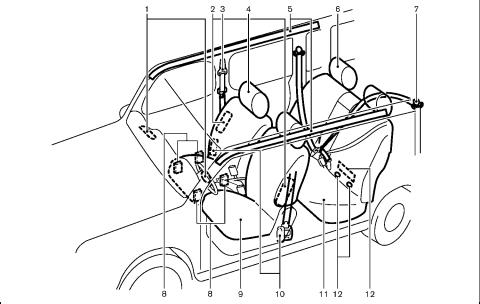
SEATS, SEAT BELTS AND
SUPPLEMENTAL RESTRAINT
SYSTEM (SRS)
10. Seat belt with pretensioners (P.1-56)
11. Rear seats* (P.1-4)
— Child restraints (P.1-23)
12. LATCH (Lower Anchors and Tethers for CHildren) system* (P.1-24)
*: except for Cargo Van models
|
SSI0659 |
|||
|
1. |
Supplemental front-impact air bags (Page 1-44) |
5. |
Roof-mounted curtain side-impact supplemental |
|
2. |
Front seat-mounted side-impact supplemental air |
air bags (P.1-44) |
|
|
bags (P.1-44) |
6. |
Rear headrests* (P.1-9) |
|
|
3. |
Seat belts (P.1-12) |
7. |
Rear center seat belt* (P.1-20) |
|
4. |
Head restraints (P.1-6) |
8. |
Occupant classification sensors (weight sensors) |
|
— Front-seat Active Head Restraints (P.1-9) |
— Advanced Air Bag System (P.1-50) |
||
|
9. |
Front seats (P.1-3) |
0-2 Illustrated table of contents
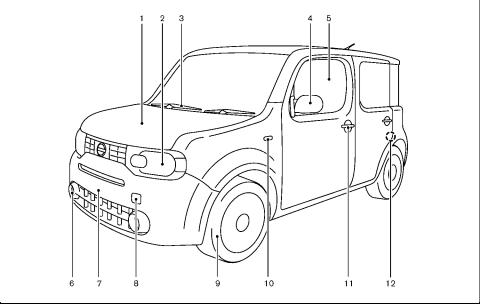
EXTERIOR FRONT
6. Fog lights*
— Switch operation (P.2-27)
— Bulb replacement (P.8-27)
7. License plate installation (P.9-11)
8. Recovery hook (P.6-15)
9. Tires
— Wheels and tires (P.8-28, P.9-7)
— Flat tire (P.6-2)
— Tire Pressure Monitoring System (TPMS) (P.2-13, P.5-3)
10. Side turn signal lights
— Switch operation (P.2-26)
— Bulb replacement (P.8-27)
11. Doors
— Keys (P.3-2)
— Door locks (P.3-4)
— Remote keyless entry system* (P.3-6)
— Intelligent Key system* (P.3-10)
— Security system (P.2-17)
12. Child safety rear door lock (P.3-6) *: if so equipped
SSI0559
1.Hood (P.3-21)
2.Headlights and turn signal lights
—Switch operation (P.2-23)
—Bulb replacement (P.8-26)
3.Windshield wiper and washer
—Switch operation (P.2-20)
—Blade replacement (P.8-17)
—Window washer fluid (P.8-12)
4.Outside mirrors (P.3-27)
5.Power windows (P.2-36)
Illustrated table of contents 0-3
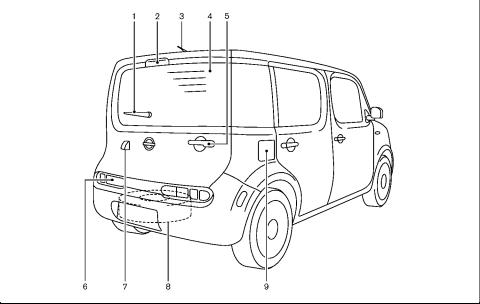
EXTERIOR REAR
9. Fuel-filler door
— Operation (P.3-24)
— Fuel recommendation (P.9-3) *: if so equipped
SSI0660
1.Rear window wiper and washer
—Switch operation (P.2-22)
—Window washer fluid (P.8-12)
2.High-mounted stop light
—Bulb replacement (P.8-27)
3.Antenna (P.4-42)
—Satellite radio antenna* (P.4-14)
0-4 Illustrated table of contents
4.Rear window defroster (P.2-23)
5.Back door (P.3-22)
—Intelligent Key system* (P.3-10)
6.Rear combination lights
—Bulb replacement (P.8-27)
7.Rearview camera* (P.4-2)
8.Spare tire (under the vehicle) (P.6-4)
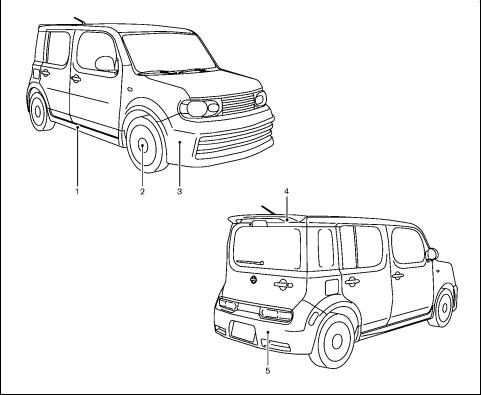
EXTERIOR (Kro¯m models)
For Kro¯m models, the vehicle parts listed below require special care or caution. Refer to additional information in each section.
1. Side sill extensions (P.3-23)
2. Aluminum alloy wheels (P.7-4)
3. Front bumper (P.3-23, P.6-14)
4. Rear spoiler (P.7-3)
5. Rear bumper (P.3-23, P.6-14)
SSI0577
Illustrated table of contents 0-5
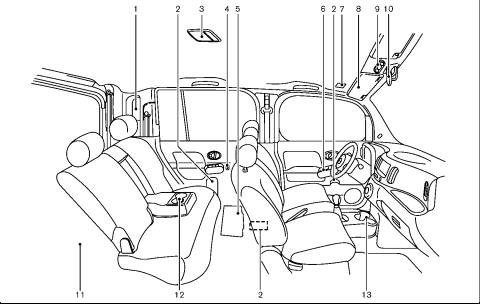
PASSENGER COMPARTMENT
9. Map lights* (P.2-38)
10. Inside rearview mirror (P.3-26)
11. Cargo area
— Luggage hooks (P.2-34)
— Cargo light* (P.2-40) 12. Rear cup holders* (P.2-31) 13. Front cup holders (P.2-31) *: if so equipped
SSI0634
|
1. |
Rear pillar pocket (P.2-34) |
6. |
Door armrest |
|
|
2. |
Soft bottle holders (P.2-33) |
— Power window switch (P.2-36) |
||
|
— Power door lock switch (P.3-5) |
||||
|
3. |
Ceiling light (P.2-39) |
|||
|
7. |
Microphone* |
|||
|
4. |
Utility hooks* (P.2-35) |
|||
|
— Bluetooth® Hands-Free Phone System* |
||||
|
5. |
Jack and tools (P.6-3) |
(P.4-44) |
||
|
8. |
Sun visors (P.3-26) |
0-6 Illustrated table of contents
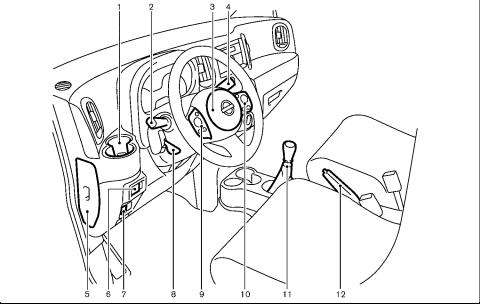
1.Front cup holders (P.2-31)
2.Headlight, fog light and turn signal switch
—Headlight (P.2-23)
—Turn signal light (P.2-26)
—Fog light* (P.2-27)
3.Steering wheel
—Electric power steering system (P.5-25)
—Horn (P.2-28)
—Driver’s supplemental air bag (P.1-44)
4.Wiper and washer switch (P.2-20)
5.Fuse box cover (P.8-21)
6.Outside mirror remote control switch (P.3-27)
7.Vehicle Dynamic Control (VDC) OFF switch (P.5-28)
8.Tilting steering wheel lever (P.3-25)
9.Steering-wheel-mounted controls (left side)*
—Audio control* (P.4-41)
—Bluetooth® Hands-Free Phone System control* (P.4-44)
10.Steering-wheel-mounted controls (right side)*
—Cruise control switches* (P.5-20)
11.Selector lever or Shift lever
—Continuously Variable Transmission (CVT) (P.5-14)
—Manual Transmission (MT) (P.5-18)
12.Parking brake (P.5-20)
*: if so equipped
Illustrated table of contents 0-7
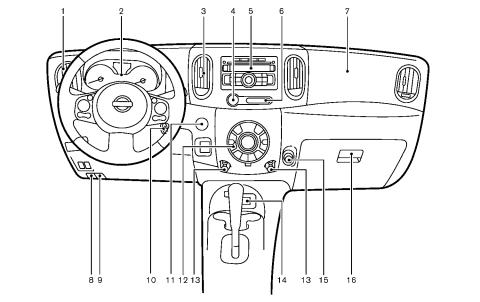
INSTRUMENT PANEL
|
SSI0562 |
|||
|
1. |
Side ventilator (P.4-5) |
6. |
Front passenger air bag status light (P.1-51) |
|
2. |
Meters and gauges (P.2-4) |
7. |
Front passenger supplemental air bag (P.1-44) |
|
3. |
Center ventilator (P.4-5) |
8. |
Fuel-filler door release handle (P.3-24) |
|
4. |
Hazard warning flasher switch (P.2-27) |
9. |
Hood release handle (P.3-21) |
|
5. |
Audio system* (P.4-13) |
10. |
Ignition switch (models without Intelligent Key |
|
— Clock* (P.2-28) |
system) (P.5-7) |
0-8 Illustrated table of contents
11.Push-button ignition switch (models with Intelligent Key system) (P.5-9)
12.Heater and air conditioner* control (P.4-6)
— Rear window and outside mirror* defroster switch (P.2-23)
13.Utility hooks* (P.2-35)
14.iPod® connector* (P.4-15)/USB connector* (P.4-17)
15.Power outlet (P.2-31)
16.Glove box (P.2-33)
*: if so equipped
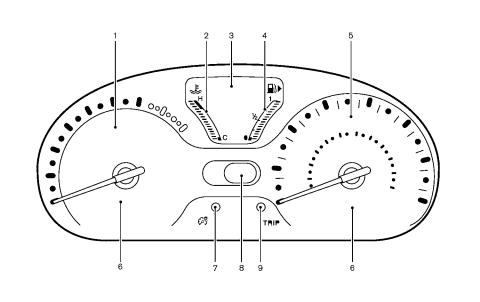
METERS AND GAUGES
|
SIC4119 |
|||
|
1. |
Tachometer (P.2-6) |
5. |
Speedometer (P.2-5) |
|
2. |
Engine coolant temperature gauge (P.2-6) |
6. |
Warning/indicator lights (P.2-10) |
|
3. |
Vehicle information display (P.2-7) |
7. |
Instrument brightness control knob (P.2-26) |
|
— Odometer/twin trip odometer (P.2-5) |
8. |
Continuously Variable Transmission (CVT) posi- |
|
— Trip computer (P.2-8) |
tion indicator* (P.2-8) |
— Outside air temperature* (P.2-7)
4.Fuel gauge (P.2-7)
9.RESET switch for trip odometer (P.2-5)/Trip computer mode switch (P.2-8)
*: if so equipped
Illustrated table of contents 0-9
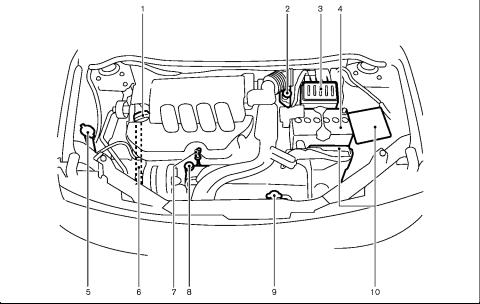
ENGINE COMPARTMENT
* Shown with the resonator removed. For removal instructions, see “ENGINE COMPARTMENT CHECK LOCATIONS” in the “8. Maintenance and do-it-yourself” section.
*1: for Manual Transmission (MT) models
SSI0564
MR18DE ENGINE*
1.Engine oil filler cap (P.8-9)
2.Brake and clutch (*1) fluid reservoir (P.8-11)
3.Air cleaner (P.8-16)
4.Battery (P.8-13)
— Jump starting (P.6-8)
0-10 Illustrated table of contents
5.Window washer fluid reservoir (P.8-12)
6.Engine drive belt location (P.8-15)
7.Engine oil dipstick (P.8-9)
8.Engine coolant reservoir (P.8-8)
9.Radiator filler cap (P.8-7)
— Vehicle overheat (P.6-11)
10.Fuse/fusible link holder (P.8-20)

1 Safety — Seats, seat belts and supplemental restraint system
Seats …………………………………………………….. 1-2 Front seats …………………………………………… 1-3 Rear seats (if so equipped) ………………………… 1-4 Head restraints ………………………………………. 1-6 Adjustable headrests (if so equipped) …………….. 1-9 Armrest (if so equipped) ………………………….. 1-12
Seat belts ……………………………………………… 1-12 Precautions on seat belt usage ………………….. 1-12 Child safety ………………………………………… 1-15 Pregnant women…………………………………… 1-16 Injured persons…………………………………….. 1-16 Three-point type seat belt ………………………… 1-16 Seat belt extenders………………………………… 1-22 Seat belt maintenance…………………………….. 1-22
Child restraints ………………………………………… 1-23 Precautions on child restraints……………………. 1-23 Lower Anchors and Tethers for CHildren System (LATCH) (except for Cargo Van models) ………… 1-24 Top tether strap child restraint……………………. 1-26
Child restraint installation using LATCH
(except for Cargo Van models) …………………… 1-28 Child restraint installation using the seat belts….. 1-33 Booster seats………………………………………….. 1-39 Precautions on booster seats…………………….. 1-39
Booster seat installation on front passenger seat
and rear seat……………………………………….. 1-41 Supplemental restraint system ……………………….. 1-44 Precautions on supplemental restraint system ….. 1-44
NISSAN Advanced Air Bag System
(front seats) ………………………………………… 1-50 Front seat-mounted side-impact supplemental
air bag and roof-mounted curtain side-impact supplemental air bag systems ……………………. 1-54 Seat belts with pretensioners (front seats) ……… 1-56 Supplemental air bag warning labels…………….. 1-57 Supplemental air bag warning light………………. 1-57 Repair and replacement procedure………………. 1-58
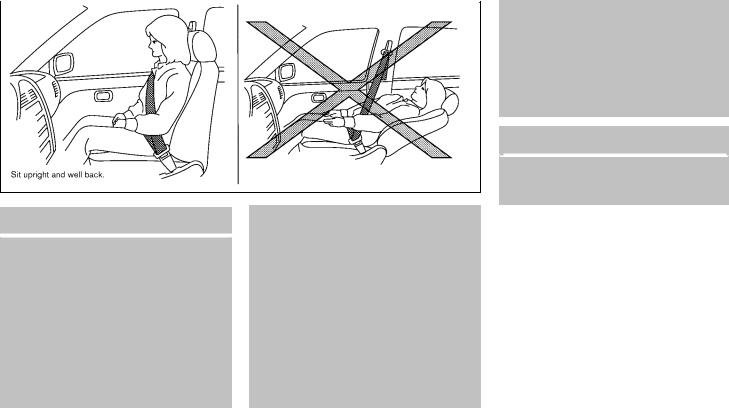

. Do not ride in a moving vehicle when the seatback is reclined. This can be dangerous. The shoulder belt will not be against your body. In an accident, you could be thrown into it and receive neck or other serious injuries. You could also slide under the lap belt and receive serious internal injuries.
. For the most effective protection when the vehicle is in motion, the seat should be upright. Always sit
well back in the seat with both feet on the floor and adjust the seat properly. See “PRECAUTIONS ON SEAT BELT USAGE” later in this section.
. After adjustment, gently rock in the seat to make sure it is securely locked.
. Do not leave children unattended inside the vehicle. They could unknowingly activate switches or controls. Unattended children could become involved in serious accidents.
1-2 Safety — Seats, seat belts and supplemental restraint system
. The seatback should not be reclined any more than needed for comfort. Seat belts are most effective when the passenger sits well back and straight up in the seat. If the seatback is reclined, the risk of sliding under the lap belt and being injured is increased.

When adjusting the seat positions, be sure not to contact any moving parts to avoid possible injuries and/or damage.

SSS0792
FRONT SEATS
Front manual seat adjustment
Forward and backward:
Pull the lever *1 up and hold it while you slide the seat forward or backward to the desired position. Release the lever to lock the seat in position.
Reclining:
To recline the seatback, pull the lever *2 up and lean back. To bring the seatback forward, pull the lever up and lean your body forward. Release the lever to lock the seatback in position.
The reclining feature allows adjustment of the seatback for occupants of different sizes for added comfort and to help obtain proper seat belt fit. (See “PRECAUTIONS ON SEAT BELT USAGE” later in this section.) Also, the seatback can be reclined to allow occupants to rest when the vehicle is stopped and the transmission is in the P (Park) position or N (Neutral) position with the parking brake fully applied.
SSS0793
Seat lifter (for driver’s seat):
Pull up or push down the adjusting lever to adjust the seat height until the desired position is achieved.
Safety — Seats, seat belts and supplemental restraint system 1-3

(except for Cargo Van models)” later in this section.)
SSS0961
REAR SEATS (if so equipped)
Forward and backward
Pull the lever *1 up and hold it while you slide the seat forward or backward to the desired position. Release the lever to lock the seat in position.
Reclining
To recline the seatback, pull the strap *2 and lean back. To bring the seatback forward, pull the strap up and lean your body forward. Release the strap to lock the seatback in position.
The reclining feature allows adjustment of the
seatback for occupants of different sizes for added comfort and to help obtain proper seat belt fit. (See “PRECAUTIONS ON SEAT BELT USAGE” later in this section.)
Folding
Before folding the rear seats:
. Secure the seat belts on the seat belt hooks on the side wall. (See “Seat belt hooks (except for Cargo Van models)” later in this section.)
. Release the connector tongue of the rear center seat belt from the buckle, and secure the connector and seat belt tongues on the seat belt hook. (See “Rear center seat belt
1-4 Safety — Seats, seat belts and supplemental restraint system
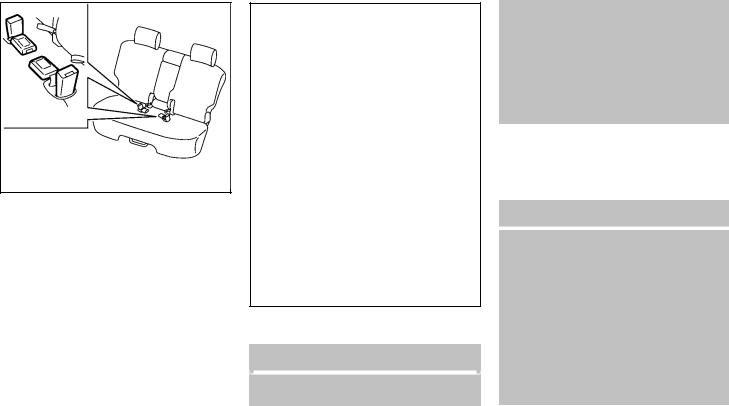
SSS0987
. Stow seat belt buckles by pushing the seat belt buckles into seat pockets.
The seat belt buckles should only be stowed when the rear seat is folded. The rear seat belt buckles should be in the unstowed position at all other times.
SSS0962
To fold down the seatback of each rear seat, pull the strap *1 or *2 .

When folding or returning the seatback(s) to the upright position, to
avoid injury to yourself and others:
. Make sure that the seat path is clear before moving the seat.
. The seatback is spring assisted and may move at a rapid rate. Be careful not to allow the seatback to pinch or hit any part of your body when you fold it.
To return the seatback to the seating position, lift up each seatback and push it to the upright position until it is latched. Unstow the seat belt buckles by pulling the buckles out of the seat pockets.

. Do not use the rear seat belts when the buckles are stowed in the seat pockets. Failure to do so may reduce the effectiveness of the entire restraint system and increase the chance or severity of injury in an accident.
. Do not fold down the rear seats when occupants are in the rear seat area or any objects are on the rear seats.
. Never allow anyone to ride in the
Safety — Seats, seat belts and supplemental restraint system 1-5
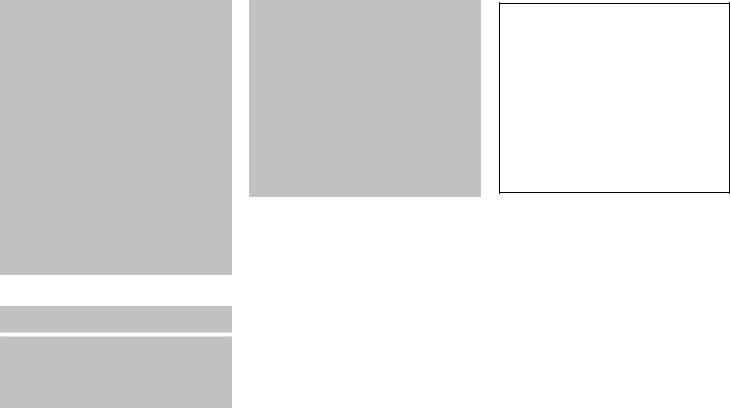
cargo area or on the rear seats when they are in the fold-down position. Use of these areas by passengers without proper restraints could result in serious injury in an accident or sudden stop.
. Properly secure all cargo with ropes or straps to help prevent it from sliding or shifting. Do not place cargo higher than the seatbacks. In a sudden stop or collision, unsecured cargo could cause personal injury.
. When returning the seatbacks to the upright position, be certain they are completely secured in the latched position. If they are not completely secured, passengers may be injured in an accident or sudden stop.
this section. Check the adjustment after someone else uses the seat. Do not attach anything to the head restraint stalks or remove the head restraint. Do not use the seat if the head restraint has been removed. If the head restraint was removed, reinstall and properly adjust the head restraint before an occupant uses the seating position. Failure to follow these instructions can reduce the effectiveness of the head restraints. This may increase the risk of serious injury or death in a collision.
HEAD RESTRAINTS

Head restraints supplement the other vehicle safety systems. They may provide additional protection against injury in certain rear end collisions. Adjust the head restraints properly, as specified in
1-6 Safety — Seats, seat belts and supplemental restraint system
SSS1019
The illustration shows the seating positions equipped with head restraints. The head restraints are adjustable.


|
SSS0992 |
SSS0997 |
SSS0993 |
|||
|
Components |
Adjustment |
To raise the head restraint, pull it up. |
|||
|
1. |
Head restraint |
Adjust the head restraint so the center is level |
|||
|
2. |
Adjustment notches |
with the center of your ears. |
|||
|
3. |
Lock knob |
||||
|
4. |
Stalks |
Safety — Seats, seat belts and supplemental restraint system 1-7

SSS0994
To lower, push and hold the lock knob and push the head restraint down.
SSS0995
Removal
Use the following procedure to remove the adjustable head restraints.
1.Pull the head restraint up to the highest position.
2.Push and hold the lock knob.
3.Remove the head restraint from the seat.
4.Store the head restraint properly in a secure place so it is not loose in the vehicle.
5.Reinstall and properly adjust the head restraint before an occupant uses the seating position.
SSS0996
Install
1.Align the head restraint stalks with the holes in the seat. Make sure that the head restraint
is facing the correct direction. The stalk with the adjustment notches *1 must be installed in the hole with the lock knob *2 .
2.Push and hold the lock knob and push the head restraint down.
3.Properly adjust the head restraint before an occupant uses the seating position.
1-8 Safety — Seats, seat belts and supplemental restraint system
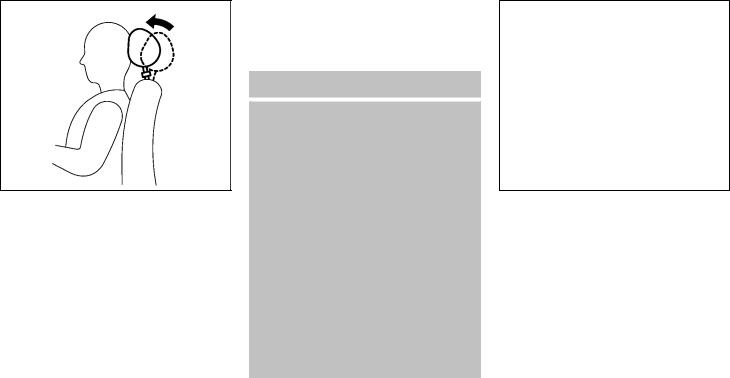
SSS0508
Front-seat Active Head Restraints
The Active Head Restraint moves forward utilizing the force that the seatback receives from the occupant in a rear-end collision. The movement of the head restraint helps support the occupant’s head by reducing its backward movement and helping absorb some of the forces that may lead to whiplash-type injuries.
Active Head Restraints are effective for collisions at low to medium speeds in which it is said that whiplash injury occurs most.
Active Head Restraints operate only in certain rear-end collisions. After the collision, the head restraints return to their original positions.
Properly adjust the Active Head Restraints as described in this section.
ADJUSTABLE HEADRESTS (if so equipped)

The adjustable headrests supplement the other vehicle safety systems. They may provide additional protection against injury in certain rear end collisions. Adjust the headrest properly, as specified in this section. Check the adjustment after someone else uses the seat. Do not attach anything to the adjustable headrest stalks or remove the adjustable headrest. Do not use the seat if the adjustable headrest has been removed. If the adjustable headrest was removed, reinstall and properly adjust the headrest before an occupant uses the seating position. Failure to follow these instructions can reduce the effectiveness of the adjustable headrests. This may increase the risk of serious injury or death in a collision.
SSS1048
The illustration shows the seating positions equipped with adjustable headrests.

Safety — Seats, seat belts and supplemental restraint system 1-9

|
SSS1034 |
SSS0997 |
SSS1035 |
|||
|
Components |
Adjustment |
To raise the headrest, pull it up. |
|||
|
1. |
Adjustable headrest |
Adjust the headrest so the center is level with |
|||
|
2. |
Adjustment notch |
the center of your ears. |
|||
|
3. |
Lock knob |
||||
|
4. |
Stalks |
1-10 Safety — Seats, seat belts and supplemental restraint system

SSS1036
To lower, push and hold the lock knob and push the headrest down.
SSS1037
Removal
Use the following procedure to remove the adjustable headrests.
1.Pull the headrest up to the highest position.
2.Push and hold the lock knob.
3.Remove the headrest from the seat.
4.Store the headrest properly in a secure place so it is not loose in the vehicle.
5.Reinstall and properly adjust the headrest before an occupant uses the seating position.
SSS1038
Install
1.Align the headrest stalks with the holes in the seat. Make sure that the headrest is
facing the correct direction. The stalk with the adjustment notch *1 must be installed in the hole with the lock knob *2 .
2.Push and hold the lock knob and push the headrest down.
3.Properly adjust the headrest before an occupant uses the seating position.
Safety — Seats, seat belts and supplemental restraint system 1-11
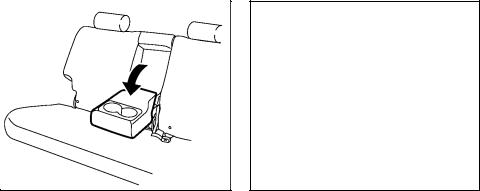
SSS0970
ARMREST (if so equipped)
Front
Pull the armrest down until it is horizontal.
SSS0963
Rear
Pull the armrest down until it is horizontal.
SEAT BELTS
PRECAUTIONS ON SEAT BELT USAGE
If you are wearing your seat belt properly adjusted, and you are sitting upright and well back in your seat with both feet on the floor, your chances of being injured or killed in an accident and/or the severity of injury may be greatly reduced. NISSAN strongly encourages you and all of your passengers to buckle up every time you drive, even if your seating position includes a supplemental air bag.
Most U.S. states and Canadian provinces or territories specify that seat belts be worn at all times when a vehicle is being driven.
1-12 Safety — Seats, seat belts and supplemental restraint system
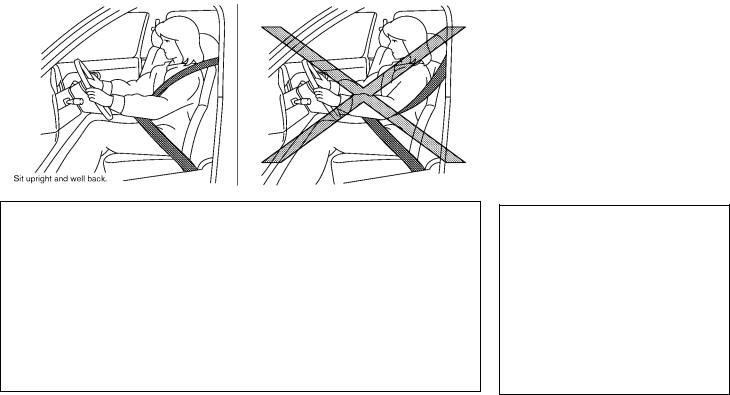
Safety — Seats, seat belts and supplemental restraint system 1-13


. Every person who drives or rides in this vehicle should use a seat belt at all times. Children should be properly restrained in the rear seat and, if appropriate, in a child restraint.
. The seat belt should be properly adjusted to a snug fit. Failure to do so may reduce the effectiveness of the entire restraint system and increase the chance or severity of injury in an accident. Serious injury or death can occur if the seat belt is not worn properly.
. Always route the shoulder belt over your shoulder and across your chest. Never put the belt behind your back, under your arm or across your neck. The belt should be away from your face and neck, but not falling off your shoulder.
. Position the lap belt as low and snug as possible AROUND THE HIPS, NOT THE WAIST. A lap belt worn too high could increase the risk of internal injuries in an accident.
. Be sure the seat belt tongue is securely fastened to the proper buckle.
. Do not wear the seat belt inside out or twisted. Doing so may reduce its effectiveness.
. Do not allow more than one person to use the same seat belt.
. Never carry more people in the vehicle than there are seat belts.
. If the seat belt warning light glows continuously while the ignition is turned ON with all doors closed and all seat belts fastened, it may indicate a malfunction in the system. Have the system checked by a NISSAN dealer.
. No changes should be made to the seat belt system. For example, do not modify the seat belt, add material, or install devices that may change the seat belt routing or tension. Doing so may affect the operation of the seat belt system. Modifying or tampering with the seat belt system may result in serious personal injury.
. Once a seat belt pretensioner has
1-14 Safety — Seats, seat belts and supplemental restraint system
activated, it cannot be reused and must be replaced together with the retractor. See a NISSAN dealer.
. Removal and installation of the pretensioner system components should be done by a NISSAN dealer.
. All seat belt assemblies, including retractors and attaching hardware, should be inspected after any collision by a NISSAN dealer. NISSAN recommends that all seat belt assemblies in use during a collision be replaced unless the collision was minor and the belts show no damage and continue to operate properly. Seat belt assemblies not in use during a collision should also be inspected and replaced if either damage or improper operation is noted.
. All child restraints and attaching hardware should be inspected after any collision. Always follow the restraint manufacturer’s inspection instructions and replacement recommendations. The child restraints should be replaced if they are damaged.

CHILD SAFETY
Children need adults to help protect them. They need to be properly restrained.
In addition to the general information in this manual, child safety information is available from many other sources, including doctors, teachers, government traffic safety offices, and community organizations. Every child is different, so be sure to learn the best way to transport your child.
There are three basic types of child restraint systems:
. Rear-facing child restraint
. Front-facing child restraint
. Booster seat
The proper restraint depends on the child’s size. Generally, infants (up to about 1 year and less than 20 lb (9 kg)) should be placed in rearfacing child restraints. Front-facing child restraints are available for children who outgrow rear-facing child restraints and are at least 1 year old. Booster seats are used to help position a vehicle lap/shoulder belt on a child who can no longer use a front-facing child restraint.

Infants and children need special protection. The vehicle’s seat belts may not
fit them properly. The shoulder belt may come too close to the face or neck. The lap belt may not fit over their small hip bones. In an accident, an improperly fitting seat belt could cause serious or fatal injury. Always use appropriate child restraints.
All U.S. states and Canadian provinces or territories require the use of approved child restraints for infants and small children. (See “CHILD RESTRAINTS” later in this section.)
Also, there are other types of child restraints available for larger children for additional protection.
NISSAN recommends that all pre-teens and children be restrained in the rear seat. According to accident statistics, children are safer when properly restrained in the rear seat than in the front seat.
This is especially important because your vehicle has a supplemental restraint system (air bag system) for the front passenger. (See “SUPPLEMENTAL RESTRAINT SYSTEM” later in this section.)
Infants
Infants up to at least 1 year old should be placed in a rear-facing child restraint. NISSAN recommends that infants be placed in child restraints
that comply with Federal Motor Vehicle Safety Standards or Canadian Motor Vehicle Safety Standards. You should choose a child restraint that fits your vehicle and always follow the manufacturer’s instructions for installation and use.
Small children
Children that are over 1 year old and weigh at least 20 lb (9 kg) can be placed in a front-facing child restraint. Refer to the manufacturer’s instructions for minimum and maximum weight and height recommendations. NISSAN recommends that small children be placed in child restraints that comply with Federal Motor Vehicle Safety Standards or Canadian Motor Vehicle Safety Standards. You should choose a child restraint that fits your vehicle and always follow the manufacturer’s instructions for installation and use.
Larger children
Children who are too large for child restraints should be seated and restrained by the seat belts which are provided. The seat belt may not fit properly if the child is less than 4 ft 9 in (142.5 cm) tall and weighs between 40 lb (18 kg) and 80 lb (36 kg). A booster seat should be used to obtain proper seat belt fit.
NISSAN recommends that a child be placed in a commercially available booster seat if the shoulder belt in the child’s seating position fits
Safety — Seats, seat belts and supplemental restraint system 1-15

close to the face or neck or if the lap portion of the seat belt goes across the abdomen. The booster seat should raise the child so that the shoulder belt is properly positioned across the top, middle portion of the shoulder and the lap belt is low on the hips. A booster seat can only be used in seating positions that have a threepoint type seat belt. The booster seat should fit the vehicle seat and have a label certifying that it complies with Federal Motor Vehicle Safety Standards or Canadian Motor Vehicle Safety Standards. Once the child has grown so the shoulder belt is no longer on or near the face and neck, use the shoulder belt without the booster seat.

Never let a child stand or kneel on any seat and do not allow a child in the cargo areas while the vehicle is moving. The child could be seriously injured or killed in an accident or sudden stop.
PREGNANT WOMEN
NISSAN recommends that pregnant women use seat belts. The seat belt should be worn snug, and always position the lap belt as low as possible around the hips, not the waist. Place the shoulder belt over your shoulder and across your chest. Never put the lap/shoulder belt over
your abdominal area. Contact your doctor for specific recommendations.
INJURED PERSONS
NISSAN recommends that injured persons use seat belts, depending on the injury. Check with your doctor for specific recommendations.
THREE-POINT TYPE SEAT BELT

. Every person who drives or rides in this vehicle should use a seat belt at all times.
. Do not ride in a moving vehicle when the seatback is reclined. This can be dangerous. The shoulder belt will not be against your body. In an accident, you could be thrown into it and receive neck or other serious injuries. You could also slide under the lap belt and receive serious internal injuries.
. For the most effective protection when the vehicle is in motion, the seat should be upright. Always sit well back in the seat with both feet on the floor and adjust the seat belt
1-16 Safety — Seats, seat belts and supplemental restraint system
properly.
Fastening the seat belts
1.Adjust the seat. (See “SEATS” earlier in this section.)
2.Make sure rear seat belt buckles are removed from the stowed position. See “Rear seat belt buckles (except for Cargo Van models)” later in this section.

SSS0292
3.Slowly pull the seat belt out of the retractor and insert the tongue into the buckle until you hear and feel the latch engage.
. The retractor is designed to lock during a sudden stop or on impact. A slow pulling motion permits the belt to move and allows you some freedom of movement in the seat.
. If the seat belt cannot be pulled from its fully retracted position, firmly pull the belt and release it. Then smoothly pull the belt out of the retractor.
SSS0290
4.Position the lap belt portion low and snug on the hips as shown.
5.Pull the shoulder belt portion toward the retractor to take up extra slack. Be sure the shoulder belt is routed over your shoulder and across your chest.
allow the driver and passengers some freedom of movement in the seat. The ELR locks the seat belt when the vehicle slows down rapidly or during certain impacts.
The Automatic Locking Retractor (ALR) mode (child restraint mode) locks the seat belt for child restraint installation.
When ALR mode is activated the seat belt cannot be extended again until the seat belt tongue is detached from the buckle and fully retracted. The seat belt returns to the ELR mode after the seat belt fully retracts. For additional information, see “CHILD RESTRAINTS” later in this section.
The ALR mode should be used only for child restraint installation. During normal seat belt use by an occupant, the ALR mode should not be activated. If it is activated, it may cause uncomfortable seat belt tension.
The front passenger seat and the rear seating positions three-point seat belts have two modes of operation:
. Emergency Locking Retractor (ELR)
. Automatic Locking Retractor (ALR)
The Emergency Locking Retractor (ELR) mode allows the seat belt to extend and retract to

When fastening the seat belts, be certain that seatbacks are completely secured in the latched position. If they are not completely secured, passengers may be injured in an accident or sudden stop.
Safety — Seats, seat belts and supplemental restraint system 1-17

SSS0326
Unfastening the seat belts
To unfasten the seat belt, push the button on the buckle. The seat belt automatically retracts.
SSS0987
Rear seat belt buckles (except for Cargo Van models)
The rear seat belt buckles can be stowed by pushing the buckles into the pockets of the seat cushion when the rear seatback is folded. The buckles should only be stowed when the seatback is folded. At all other times the seat belt buckles must be pulled out of the pockets in the unstowed position.

Do not use the rear seat belts when the buckles are stowed in the seat pockets. Failure to do so may reduce the effec-
1-18 Safety — Seats, seat belts and supplemental restraint system
tiveness of the entire restraint system and increase the chance or severity of injury in an accident.
Checking seat belt operation
Seat belt retractors are designed to lock seat belt movement by two separate methods:
. When the belt is pulled quickly from the retractor.
. When the vehicle slows down rapidly.
To increase your confidence in the seat belts, check the operation as follows:
. Grasp the shoulder belt and pull forward quickly. The retractor should lock and restrict further belt movement.
If the retractor does not lock during this check or if you have any question about seat belt operation, see a NISSAN dealer.

SSS0351A
Shoulder belt height adjustment (for front seats)
The shoulder belt anchor height should be adjusted to the position best for you. (See “PRECAUTIONS ON SEAT BELT USAGE” earlier in this section.)
To adjust, pull the adjustment button *1 , and then move the shoulder belt anchor to the desired position *2 , so that the belt passes over the center of the shoulder. The belt should be away from your face and neck, but not falling off of your shoulder. Release the adjustment button to lock the shoulder belt anchor into position.

. After adjustment, release the adjustment button and try to move the shoulder belt anchor up and down to make sure it is securely fixed in position.
. The shoulder belt anchor height should be adjusted to the position best for you. Failure to do so may reduce the effectiveness of the entire restraint system and increase the chance or severity of injury in an accident.
SSS0964
Seat belt hooks (except for Cargo Van models)
When the rear seat belts are not in use and when folding down the rear seats, hook the rear outer seat belts on the seat belt hooks.
The hook for the rear center seat belt is located on the left wall behind the rear seat. (See “Rear center seat belt (except for Cargo Van models)” later in this section for details.)
Safety — Seats, seat belts and supplemental restraint system 1-19

SSS0391
Rear center seat belt (except for Cargo Van models)
The rear center seat belt has a connector tongue *1 and a seat belt tongue *2 . Both the connector tongue and the seat belt tongue must be securely latched for proper seat belt operation.
SSS0241

. Always fasten the connector tongue and the seat belt in the order shown.
. Always make sure both the connector tongue and the seat belt tongue are secured when using the seat belt or installing a child restraint. Do not use the seat belt or child restraint with only the seat belt tongue attached. This could result in serious personal injury in case of an accident or a sudden stop.
SSS0703
The center seat belt buckle and the tongue are identified by the CENTER mark. The center seat belt tongue can be fastened only into the center seat belt buckle.
1-20 Safety — Seats, seat belts and supplemental restraint system

Stowing rear center seat belt:
When folding down the rear seat, the rear center seat belt can be retracted into a stowed position as follows:
1.Hold the connector tongue *1 so that the seat belt does not retract suddenly when the
tongue is released from the connector buckle. Release the connector tongue *1 by inserting a suitable tool such as key *2 into the connector buckle.
2.Retract the seat belt and secure the seat
belt tongue and connector tongue on the seat belt hook *3 .

. Do not unfasten the rear center seat belt connector except when folding down the rear seat.
. When returning the seatback, be sure to attach the rear center seat belt connector.
SSS0965
SSS0966
Attaching rear center seat belt:
Always be sure the rear center seat belt connector tongue and connector buckle are attached. Disconnect only when folding down the rear seat.
Safety — Seats, seat belts and supplemental restraint system 1-21

To connect the buckle:
1.Remove the seat belt tongue and connector tongue from the seat belt hook *1 .
2.Pull the seat belt and secure the connector buckle until it clicks *2 .
The rear center seat belt connector tongue can be attached only into the rear center seat belt connector buckle.
To fasten the seat belt, see “Fastening the seat belts” earlier in this section.

. When attaching the rear center seat belt connector, be certain that the seatbacks are completely secured in the latched position and the rear center seat belt connector is completely secured.
. If the rear center seat belt connector and the seatbacks are not secured in the correct position, serious personal injury may result in an accident or sudden stop.
SEAT BELT EXTENDERS
If, because of body size or driving position, it is not possible to properly fit the lap-shoulder belt and fasten it, an extender that is compatible with the installed seat belts is available that can be purchased. The extender adds approximately 8 in (200 mm) of length and may be used for either the driver or front passenger seating position. See a NISSAN dealer for assistance with purchasing an extender if an extender is required.

. Only NISSAN seat belt extenders, made by the same company which made the original equipment seat belts, should be used with NISSAN seat belts.
. Adults and children who can use the standard seat belt should not use an extender. Such unnecessary use could result in serious personal injury in the event of an accident.
. Never use seat belt extenders to install child restraints. If the child restraint is not secured properly, the child could be seriously injured in a collision or a sudden stop.
1-22 Safety — Seats, seat belts and supplemental restraint system
SEAT BELT MAINTENANCE
. To clean the seat belt webbing, apply a mild soap solution or any solution recommended for cleaning upholstery or carpets. Then wipe with a cloth and allow the seat belts to dry in the shade. Do not allow the seat belts to retract until they are completely dry.
. If dirt builds up in the shoulder belt guide of the seat belt anchors, the seat belts may retract slowly. Wipe the shoulder belt guide with a clean, dry cloth.
. Periodically check to see that the seat belt and the metal components, such as buckles, tongues, retractors, flexible wires and anchors, work properly. If loose parts, deterioration, cuts or other damage on the webbing is found, the entire seat belt assembly should be replaced.

CHILD RESTRAINTS
SSS0099
SSS0100
PRECAUTIONS ON CHILD
RESTRAINTS

. Infants and small children should always be placed in an appropriate child restraint while riding in the vehicle. Failure to use a child restraint can result in serious injury or death.
. Infants and small children should never be carried on your lap. It is not possible for even the strongest adult to resist the forces of a severe accident. The child could be crushed between the adult and parts of the vehicle. Also, do not put the same seat belt around both your child and yourself.
. Even with the NISSAN Advanced Air Bag System, never install a rearfacing child restraint in the front seat. An inflating front air bag could seriously injure or kill your child. A rear-facing child restraint must only be used in the rear seat.
. NISSAN recommends that the child restraint be installed in the rear
seat. According to accident statistics, children are safer when properly restrained in the rear seat than in the front seat. If you must install a front-facing child restraint in the front seat, see “CHILD RESTRAINT INSTALLATION USING THE SEAT BELTS” later in this section.
. Improper use or improper installation of a child restraint can increase the risk or severity of injury for both the child and other occupants of the vehicle and can lead to serious injury or death in an accident.
. Follow all of the child restraint manufacturer’s instructions for installation and use. When purchasing a child restraint, be sure to select one which will fit your child and vehicle. It may not be possible to properly install some types of child restraints in your vehicle.
. If the child restraint is not anchored properly, the risk of a child being injured in a collision or a sudden stop greatly increases.
. Child restraint anchor points are designed to withstand only those
Safety — Seats, seat belts and supplemental restraint system 1-23

loads imposed by correctly fitted child restraints. Under no circumstances are they to be used for adult seat belts or harnesses.
. Adjustable seatbacks should be positioned to fit the child restraint, but as upright as possible.
. After attaching the child restraint, test it before you place the child in it. Push it from side to side while holding the seat near the LATCH attachment or near the seat belt path. The child restraint should not move more than 1 inch (25 mm) from side to side. Try to tug it forward and check to see if the belt holds the restraint in place. If the restraint is not secure, tighten the belt as necessary, or put the restraint in another seat and test it again. You may need to try a different child restraint. Not all child restraints fit in all types of vehicles.
. When your child restraint is not in use, keep it secured with the LATCH system or a seat belt to prevent it from being thrown around in case of a sudden stop or accident.

Remember that a child restraint left in a closed vehicle can become very hot. Check the seating surface and buckles before placing your child in the child restraint.
This vehicle is equipped with a universal child restraint lower anchor system, referred to as the Lower Anchors and Tethers for CHildren System or LATCH. Some child restraints include two rigid or webbing-mounted attachments that can be connected to these lower anchors. For details, see “Lower Anchors and Tethers for CHildren System (LATCH) (except for Cargo Van models)” later in this section.
If you do not have a LATCH compatible child restraint, the vehicle seat belts can be used. (See “CHILD RESTRAINT INSTALLATION USING THE SEAT BELTS” later in this section.) In general, child restraints are also designed to be installed with a lap/shoulder seat belt.
Several manufacturers offer child restraints for infants and small children of various sizes. When selecting any child restraint, keep the following points in mind:
. Choose only a restraint with a label certifying that it complies with Federal Motor Vehicle Safety Standard 213 or Canadian Motor
1-24 Safety — Seats, seat belts and supplemental restraint system
Vehicle Safety Standard 213.
. Check the child restraint in your vehicle to be sure it is compatible with the vehicle’s seat and seat belt system.
. If the child restraint is compatible with your vehicle, place your child in the child restraint and check the various adjustments to be sure the child restraint is compatible with your child. Choose a child restraint that is designed for your child’s height and weight. Always follow all recommended procedures.
All U.S. states and Canadian provinces or territories require that infants and small children be restrained in an approved child restraint at all times while the vehicle is being operated. Canadian law requires the top tether strap on front-facing child restraints be secured to the designated anchor point on the vehicle.
Lower Anchors and Tethers for CHildren System (LATCH) (except for Cargo Van models)
Your vehicle is equipped with special anchor points that are used with Lower Anchors and Tethers for CHildren System (LATCH) compatible child restraints. This system may also be referred to as the ISOFIX or ISOFIX compatible system. With this system, you do not have to use a vehicle seat belt to secure the child restraint.

The LATCH anchor points are provided to install child restraints in the rear outboard seating positions only. Do not attempt to install a child restraint in the center position using the LATCH anchors.
SSS0801
LATCH system anchor location
SSS0637
LATCH system lower anchor
LATCH lower anchor point locations
The LATCH anchors are located at the rear of the seat cushion near the seatback. A label is attached to the seatback to help you locate the LATCH anchors.

. Attach LATCH system compatible child restraints only at the locations shown in the illustration. If a child restraint is not secured properly, your child could be seriously injured or killed in an accident.
. Do not secure a child restraint in the center rear seating position using the LATCH anchors. The child restraint will not be secured properly.
. Child restraint anchor points are designed to withstand only those loads imposed by correctly fitted child restraints. Under no circumstances are they to be used for adult seat belts or harnesses.
Safety — Seats, seat belts and supplemental restraint system 1-25

SSS0643
LATCH webbing-mounted attachment
Installing child restraint LATCH anchor attachments
LATCH compatible child restraints include two rigid or webbing-mounted attachments that can be connected to two anchors located at certain seating positions in your vehicle. With this system, you do not have to use a vehicle seat belt to secure the child restraint. Check your child restraint for a label stating that it is compatible with LATCH system. This information may also be in the instructions provided by the child restraint manufacturer.
SSS0644
LATCH rigid-mounted attachment
LATCH child restraints generally require the use of a top tether strap. (See “TOP TETHER STRAP CHILD RESTRAINT” later in this section for installation instructions.)
When installing a child restraint, carefully read and follow the instructions in this manual and those supplied with the child restraint. (See “CHILD RESTRAINT INSTALLATION USING LATCH (except for Cargo Van models)” later in this section.)
1-26 Safety — Seats, seat belts and supplemental restraint system
TOP TETHER STRAP CHILD RESTRAINT
If the manufacturer of your child restraint requires the use of a top tether strap, it must be secured to an anchor point.

. Child restraint anchor points are designed to withstand only those loads imposed by correctly fitted child restraints. Under no circumstances are they to be used for adult seat belts or harnesses.
. If the cargo cover contacts the top tether strap when it is attached to the top tether anchor, remove the cargo cover from the vehicle or secure it on the cargo floor below its attachment location. If the cargo cover is not removed, it may damage the top tether strap during a collision. Your child could be seriously injured or killed in a collision if the child restraint top tether strap is damaged.
. Do not allow cargo to contact the top tether strap when it is attached to the top tether anchor. Properly

secure the cargo so it does not contact the top tether strap. Cargo that is not properly secured or that contacts the top tether strap may damage the top tether strap during a collision. Your child could be seriously injured or killed in a collision if the child restraint top tether strap is damaged.
Top tether anchor point locations
Anchor points are located in the following locations.
. On the seat cushion behind the outboard and center seating positions (except for Cargo Van models)
. On the floor behind the front passenger seat (Cargo Van models)
SSS0986

Do not attach upper tether anchors to the luggage hooks. The child restraint will not be properly installed. Your child could be injured or killed in a sudden stop or collision.
Installing top tether strap
First secure the child restraint with the LATCH system (except for Cargo Van models: rear outboard seating positions only) or the seat belt as applicable.
SSS0967
Rear seats (except for Cargo Van models):
1.Position the top tether strap over the top of the seatback and under the headrest.
2.Secure the tether strap to the tether anchor on the seat directly behind the child restraint.
3.Tighten the tether strap according to the manufacturer’s instructions to remove any slack.
For the best child restraint fit, see the child restraint installation instructions in this section and the child restraint manufacturer’s instructions.
Safety — Seats, seat belts and supplemental restraint system 1-27

If you have any questions when installing a top tether strap child restraint on the rear seat, consult your NISSAN dealer for details.
SSS1039
Front passenger seat (Cargo Van models):
For the front passenger seat in Cargo Van models, install the top tether strap according to the following procedure.
1. Adjust the head restraint to its highest position.
2. Route the top tether strap between the head restraint and the top of the seatback.
3. Secure the tether strap to the tether anchor point on the floor behind the seat.
4. Tighten the tether strap according to the manufacturer’s instructions to remove any slack.
1-28 Safety — Seats, seat belts and supplemental restraint system
For the best child restraint fit, see the child restraint installation instructions in this section and the child restraint manufacturer’s instructions.
If you have any questions when installing a top tether strap child restraint on the front passenger’s seat, consult your NISSAN dealer for details.
CHILD RESTRAINT INSTALLATION USING LATCH (except for Cargo Van models)

. Attach LATCH system compatible child restraints only at the locations shown. For the LATCH lower anchor locations, see “Lower Anchors and Tethers for CHildren System (LATCH) (except for Cargo Van models)” earlier in this section. If a child restraint is not secured properly, your child could be seriously injured or killed in an accident.
. The LATCH anchors are designed to withstand only those loads imposed by correctly fitted child restraints. Under no circumstance are they to be used for adult seat belts or

harnesses.
. Inspect the lower anchors by inserting your fingers into the lower anchor area and feeling to make sure there are no obstructions over the LATCH anchors, such as seat belt webbing or seat cushion material. The child restraint will not be secured properly if the LATCH anchors are obstructed.
Front-facing
Follow these steps to install a front-facing child restraint using LATCH system:
1.Adjust the rear seat to the upright and rearmost position.
2.Position the child restraint on the seat. Always follow the child restraint manufacturer’s instructions.
|
SSS0645 |
SSS0646 |
|
|
Front-facing (webbing-mounted) — step 3 |
Front-facing (rigid-mounted) — step 3 |
3.Secure the child restraint anchor attachments to the LATCH lower anchors. Check to make sure the LATCH attachment is properly attached to the lower anchors.
Safety — Seats, seat belts and supplemental restraint system 1-29

4.The back of the child restraint should be secured against the seatback.
If necessary, remove the headrest to obtain the correct child restraint fit. (See “ADJUSTABLE HEADRESTS” earlier in this section.)
If the headrest is removed, store it in a secure place. Be sure to reinstall the headrest when the child restraint is removed. If the seating position does not have a removal headrest and it is interfering with the proper child restraint fit, try another seating position or a different child restraint.
SSS0647
Front-facing — step 5
5. For child restraints that are equipped with webbing-mounted attachments, remove any additional slack from the anchor attachments. Press downward and rearward firmly in the center of the child restraint with your knee to compress the vehicle seat cushion and seatback while tightening the webbing of the anchor attachments.
6. If the child restraint is equipped with a top tether strap, route the top tether strap and secure the tether strap to the tether anchor point. (See “TOP TETHER STRAP CHILD RESTRAINT” earlier in this section.)
SSS0638
Front-facing — step 7
7.After attaching the child restraint, test it before you place the child in it. Push it from side to side while holding the seat near the LATCH attachment path. The child restraint should not move more than 1 inch (25 mm) from side to side. Try to tug it forward and check to see if the LATCH attachment holds the restraint in place. If the restraint is not secure, tighten the LATCH attachment as necessary, or put the restraint in another seat and test it again. You may need to try a different child restraint. Not all child restraints fit in all types of vehicles.
1-30 Safety — Seats, seat belts and supplemental restraint system

8.Check to make sure the child restraint is properly secured prior to each use. If the child restraint is loose, repeat steps 3 through 7.
Rear-facing
Follow these steps to install a rear-facing child restraint using LATCH system:
1.Adjust the rear seat to the upright and rearmost position.
2.Position the child restraint on the seat. Always follow the child restraint manufacturer’s instructions.
|
SSS0648 |
SSS0649 |
|
|
Rear-facing (webbing-mounted) — step 3 |
Rear-facing (rigid-mounted) — step 3 |
3.Secure the child restraint anchor attachments to the LATCH lower anchors. Check to make sure the LATCH attachment is properly attached to the lower anchors.
Safety — Seats, seat belts and supplemental restraint system 1-31

SSS0639
Rear-facing — step 4
4.For child restraints that are equipped with webbing-mounted attachments, remove any additional slack from the anchor attachments. Press downward and rearward firmly in the center of the child restraint with your hand to compress the vehicle seat cushion and seatback while tightening the webbing of the anchor attachments.
SSS0650
Rear-facing — step 5
5.After attaching the child restraint, test it before you place the child in it. Push it from side to side while holding the seat near the LATCH attachment path. The child restraint should not move more than 1 inch (25 mm) from side to side. Try to tug it forward and check to see if the LATCH attachment holds the restraint in place. If the restraint is not secure, tighten the LATCH attachment as necessary, or put the restraint in another seat and test it again. You may need to try a different child restraint. Not all child restraints fit in all types of vehicles.
6.Check to make sure the child restraint is properly secured prior to each use. If the child restraint is loose, repeat steps 3 through 5.
1-32 Safety — Seats, seat belts and supplemental restraint system

SSS0100
CHILD RESTRAINT INSTALLATION USING THE SEAT BELTS

. Even with the NISSAN Advanced Air Bag System, never install a rearfacing child restraint in the front passenger seat. Front air bags inflate with great force. A rear-facing child restraint could be struck by the front air bag in a crash and could seriously injure or kill your child.
. NISSAN recommends that child restraints be installed in the rear seat.
However, if you must install a frontfacing child restraint in the front passenger seat, move the passenger seat to the rearmost position. Also, be sure the front passenger air bag status light is illuminated to indicate the passenger air bag is OFF. See “Front passenger air bag and status light” later in this section for details.
. The three-point seat belt in your vehicle is equipped with an Automatic Locking Retractor (ALR) which must be used when installing a child restraint.
. Failure to use the ALR mode will result in the child restraint not being properly secured. The restraint could tip over or otherwise be unsecured and cause injury to the child in a sudden stop or collision.
. A child restraint with a top tether strap should not be used in the front passenger seat (except for Cargo Van models).
The instructions in this section apply to child restraint installation using the vehicle seat belts in the rear seat or the front passenger seat.
. When using the rear center seat belt to install a child restraint, make sure the connector tongue and the seat belt tongue are secured. Do not use the seat belt with only the seat belt tongue attached. This could result in serious personal injury in case of an accident or sudden stop.
Safety — Seats, seat belts and supplemental restraint system 1-33

SSS0640
Front-facing (front passenger seat) — step 1
Front-facing
Follow these steps to install a front-facing child restraint using the vehicle seat belt in the rear seat (except for Cargo Van models) or in the front passenger seat:
1.Adjust the rear seat to the upright and rearmost position.
If you must install a child restraint in the front seat, it should be placed in a front-facing direction only. Move the seat to the rearmost position. Child restraints for infants must be used in the rear-facing direction and therefore must not be used in the front seat.
2.Position the child restraint on the seat. Always follow the child restraint manufacturer’s instructions.
The back of the child restraint should be secured against the seatback.
If necessary, adjust the head restraint (front passenger seat only) or remove the head restraint/headrest to obtain the correct child restraint fit. (See “HEAD RESTRAINTS” earlier in this section and “ADJUSTABLE HEADRESTS” earlier in this section.)
If the head restraint/headrest is removed, store it in a secure place. Be sure to reinstall the head restraint/headrest when the child restraint is removed.
If the seating position does not have a removable head restraint/headrest and it is interfering with the proper child restraint fit, try another seating position or a different child restraint.
1-34 Safety — Seats, seat belts and supplemental restraint system
SSS0360B
Front-facing — step 3
3.Route the seat belt tongue through the child restraint and insert it into the buckle until you hear and feel the latch engage. Be sure to follow the child restraint manufacturer’s instructions for belt routing.

Полное руководство по эксплуатации, ремонту и техническому обслуживанию автомобиля Nissan Cube Z12 с 2010 года выпуска.
Год выпуска: 2010
Язык: Английский
Разработчик: Nissan Motor Co., Ltd.
Формат: PDF
размер: 66 мб.
Скачать руководство по ремонту Nissan Cube Z12
Внимание! У Вас нет прав для просмотра скрытого текста.
Размещено в разделе Литература, софт, 14.10.2013 г.,
Просмотров 6 302,
Комментариев 1
Еще похожие на «Руководство по ремонту автомобиля Nissan Cube Z12 с 2010 года выпуска» материалы:
Комментарии к этому материалу:



